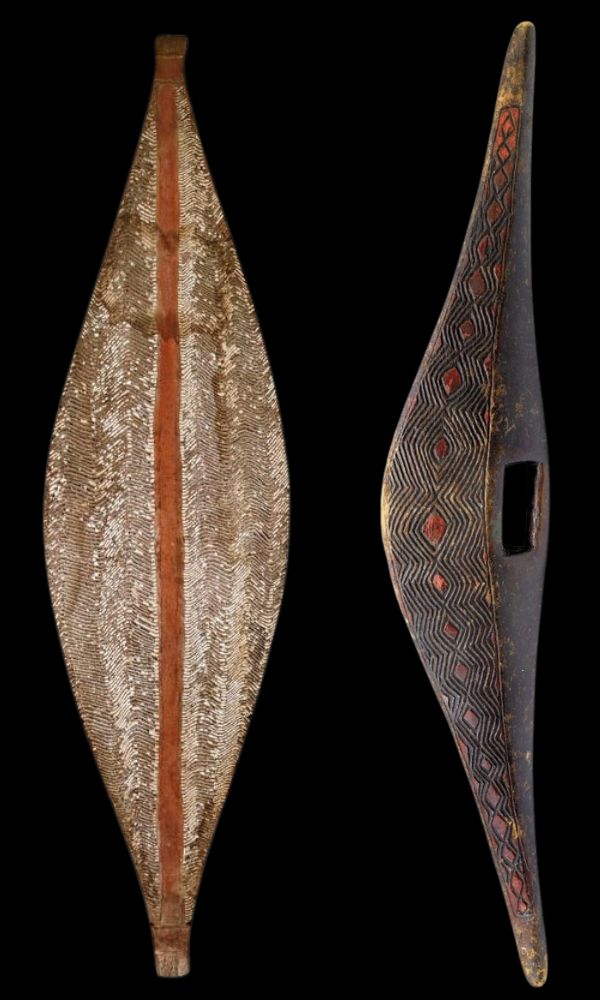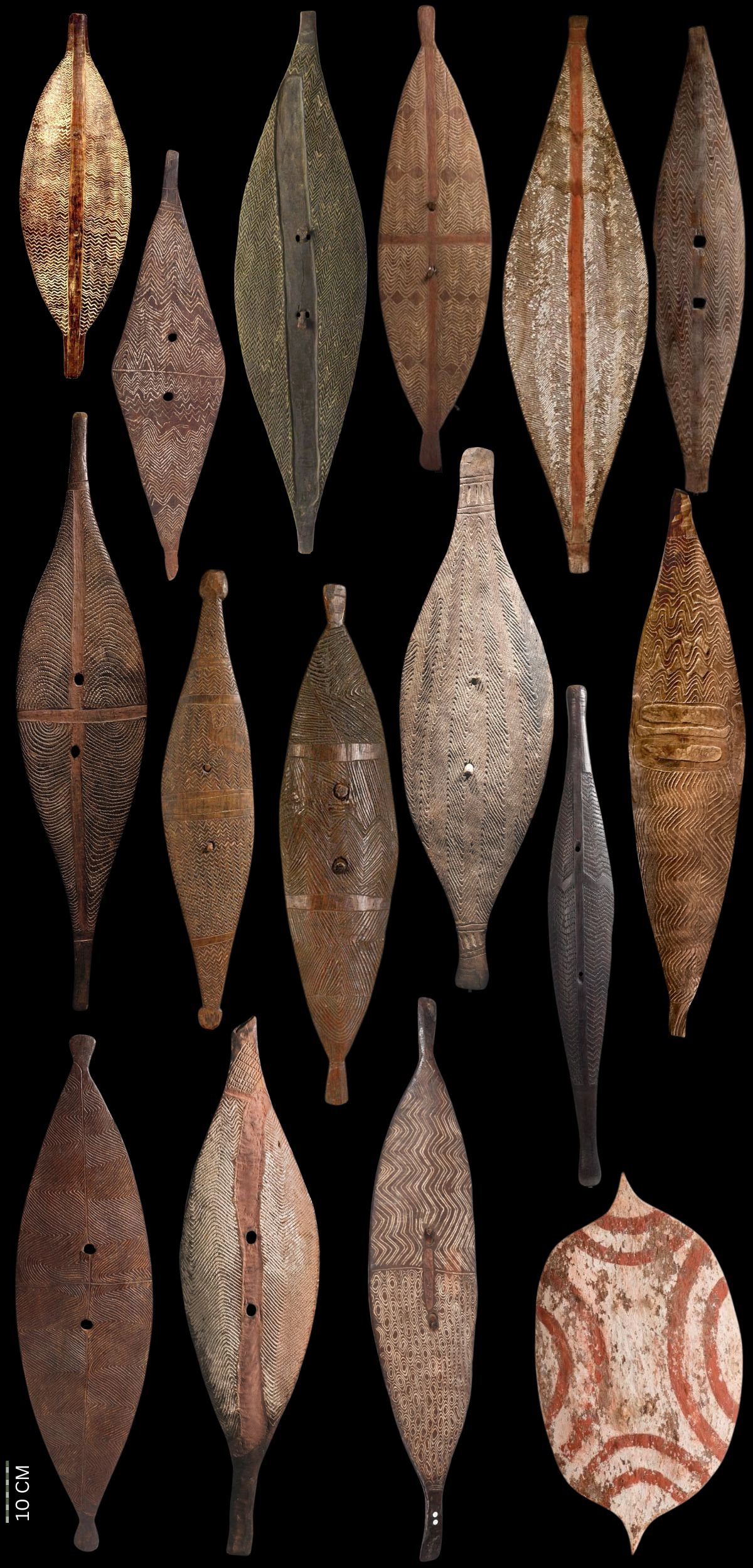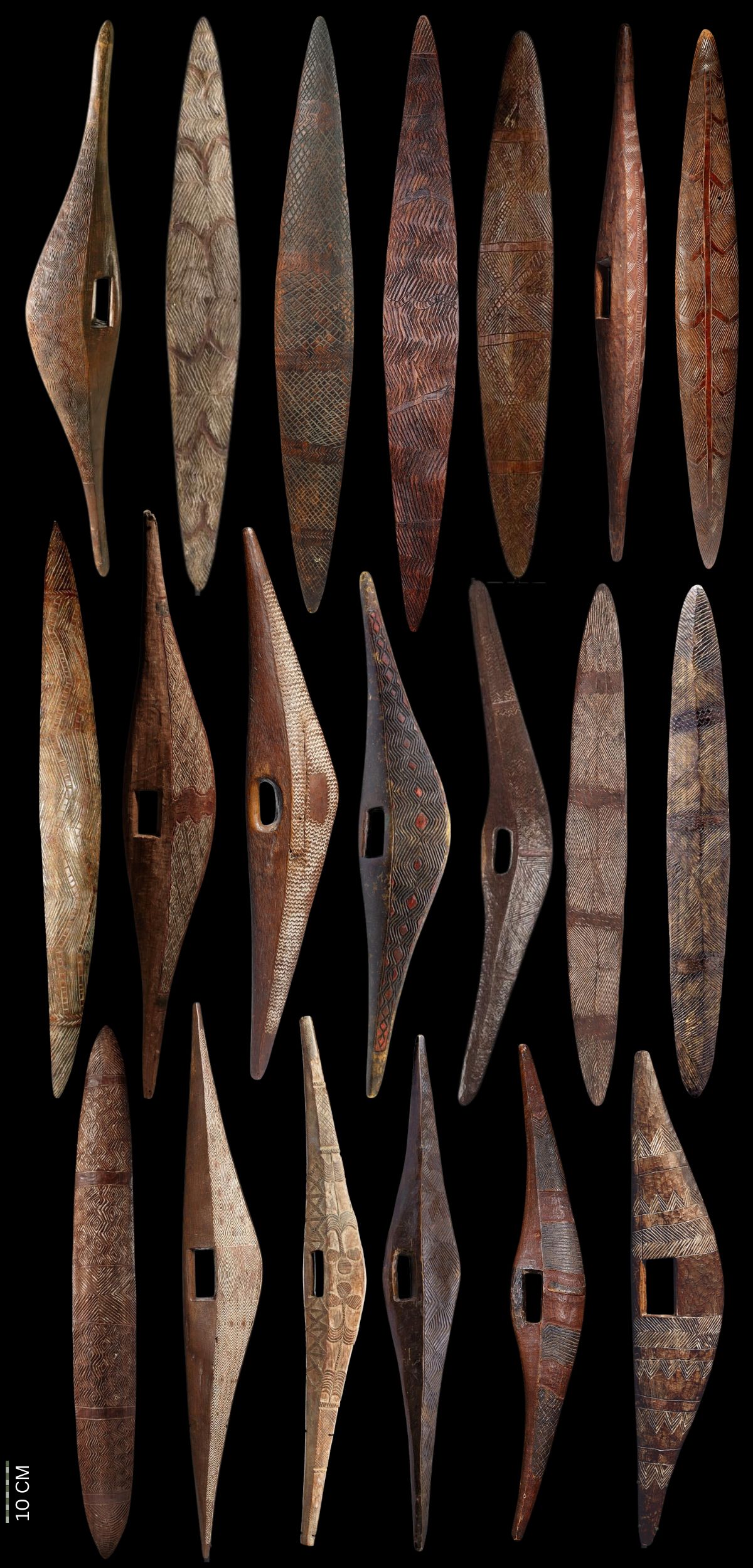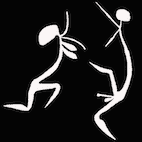South East Australian Aboriginal Broad Shields
Aboriginal Broad Shields and Parrying shields
South East Australian Aboriginal shields are highly collectible, with two primary types:
-
Aboriginal Broad Shield
Broad shields were primarily used for protection against projectile weapons, such as boomerangs, spears, and throwing clubs. These shields range from 60cm to 120 cm and designed to deflect attacks, making them crucial in both combat and ceremonial contexts. Broad shields are the most collectible and valuable type of Aboriginal shield.
-
Aboriginal Parrying Shields
Parrying shields range from 65 cm to 100cm and were crafted for one-on-one ritualized combat. These shields were used in direct confrontations, often during traditional interclan or inter-tribal tournaments, where warriors would engage in hand-to-hand combat. While still valuable, parrying shields are generally less collectible than broad shields.
Collectability of South East Australian Aboriginal broad Shields
Both broad and parrying shields are highly prized by collectors, but broad shields, due to their visual impact rarity, design, and historical significance, are considerably more sought after and valuable. Most of these shields were collected during the 1800s and early 1900s, making original examples rare and hard to come by.
Despite their cultural importance, there is very little recorded information about South East Australian Aboriginal shields. Many of the shields collected in the 19th and early 20th centuries were accompanied by minimal or no documentation, leaving gaps in understanding the full history and significance of these remarkable artefacts.
If you have a South East Australian Shield either broad shield or parrying shield and want to know what it is worth please feel free to send me images via email of the front, back and side profile along with the size.

Aboriginal Broad Shield: Construction, Decoration, and Usage
South East Australian broad shields are the most valuable and highly collectible among all Aboriginal shields, with antique examples often fetching tens of thousands of dollars. These shields are easily recognizable by their distinctive reversed hourglass shape. The term “broad” refers to the shield’s flat face, and they are sometimes called “spear shields” because they were primarily designed to deflect spears. Black highlights that traditional shield-makers from Victoria used possum-tooth engraving tools to incise the face of their shields. These shields, commonly known as gee-am (geeam, giam) or kereem in south-eastern Australia, and bamarook near Lake Tyers, were actually produced along the Murray River drainage basin, where they are referred to as karagarm.

Techniques of Aboriginal Broad Shield Construction
South-east aboriginal broad shields were traditionally crafted using two primary methods:
- Carving from a Living Tree
The most common method involves carving the shield from the inner bark of the Manna Gum tree (Eucalyptus viminalis) . The artisan would cut the shape from beneath the outer bark of the tree, shaping it into the reversed hourglass form. The shield maker would remove the flat shield slab, which would then be whittled thinner and flatter and warped by heat to curve in either direction. The shield was drilled in two places, and a handle was carved from a green branch. The imbedded grip, once dried, is so firmly attached that it is virtually impossible to remove. After the shield was shaped and drilled, the surface would be incised with designs specific to the tribe or clan. While some suggest these designs could serve as the maker’s signature, it is more likely that they represent clan-specific totemic symbols. - Carving from a Single Piece of Wood
The second technique became more prevalent after the introduction of steel tools. In this method, both the shield and the handle were carved from a single piece of wood, creating a design that was both functional and aesthetically striking. Shields with separate handles may lose their handles over time, but the shield still retains most of its value.

Broad Shield Decoration
South-east Australian aboriginal broad shields are often adorned with intricate incised designs. These designs include concentric diamond shapes, herringbone patterns, along with parallel chevron and diagonal flutings. The designs are usually symmetrical, adding to the visual appeal of the shield. Shields from the Murray River region, in particular, often feature panels separated by uncarved strips. These strips, typically painted in contrasting colors (often red), create a striking effect when paired with the grooved patterns carved into the shield’s surface.
The aesthetic beauty of the incised design and whether the patterns were created using neolithic or steel tools significantly impacts the shield’s value. The level of detail and the craftsmanship displayed in these shields make them highly desirable among collectors.
Use of Aboriginal Broad Shields
Aboriginal broad shields were primarily used for protection in traditional combat, particularly in defense against projectiles like spears and throwing clubs during formalized intertribal battles. While the shields were crucial in such rare confrontations, the most common form of Aboriginal warfare was small-scale raids or “payback” expeditions targeting specific individuals. These raids, typically involving a small group of men, focused on surprise ambushes and quick escapes.
These raids, typically involving a small group of men, focused on surprise ambushes and quick escapes. These shields were utilized in group skirmishes rather than in strict single combat or duels and, because of their parrying-like points on both ends, may have functioned both for protection and offense. due to the nature of these raids, broad shields were not used frequently in everyday conflict.
Broad shields likely played a key role in the spectacular intertribal “tournaments” to settle disputes. These tournaments, which could involve hundreds of participants, were highly formalized events held between tribes. They often began with volleys of projectiles, at which point the broad shields proved invaluable in deflecting the incoming attacks. As the battles progressed, seasoned warriors would engage in one-on-one combat using boomerang-shaped clubs, Leangle clubs, and parrying shields.
East Australian Aboriginal Parrying Shields
East Australian parrying shields, while more common and less valuable than broad shields, are still highly sought after by collectors due to their historical significance and aesthetic beauty. These shields were traditionally carved from a single piece of wood and are typically deeper than they are wide. The handle is carved through the center of the shield’s reverse side, usually in an oblong shape, offering a secure grip during use.
The front of parrying shields often features intricate incised designs that represent clan affiliations, while the back is usually left plain. From a side profile, the front of the shield is bowed, which is to assist in deflecting blows, such as those from a club, by redirecting the impact.
Parrying shields were primarily used in inter-tribal tournaments, where warriors would engage in one-on-one combat, often armed with a Leangle club or a Boomerang club. These tournaments were typically fought between individuals of the same initiation status, and both fighters would use the same pair of weapons. The Leangle club, a bent club designed to maneuver around the parrying shield, made it significantly more difficult to defend against. In addition to these tournaments, one-on-one battles using massive heavy one-meter-plus boomerang-shaped clubs and parrying shields also occurred, with fighters trading blows while deflecting each other’s attacks.
Despite their association with combat, very few parrying shields in collections show substantial damage, suggesting that large-scale intertribal conflicts were relatively rare.
When evaluating the value of a parrying shield, several factors should be considered. The overall shape or form,and surface designs are important, but perhaps the most crucial element is the shield’s age and whether it was carved using neolithic or European tools. Shields crafted with traditional neolithic methods are far more valuable due to their rarity.

The Purpose and Significance of South-East Australian Aboriginal Art
One of the most defining features of Aboriginal art from South-East Australia is its consistency across various mediums—whether carved into wood, painted on skin, or inscribed on rock. These designs and patterns form a shared visual language, deeply rooted in the cultural tradition. However, colonization in Victoria, described by historian Janet McCalman as one of the fastest and most comprehensive in the world, led to the disruption and loss of many traditional practices, including the meanings behind Aboriginal art. This resulted in the erosion and loss of cultural knowledge and social structures within these communities.
Incised designs were a depiction of country, ancestral heritage and clan identity One of the most significant examples of Aboriginal mark-making as a form of communication is the Batman Treaty of 1835. In this event, European settler John Batman attempted to acquire land from the Woiwurrung and Boonwurrung people near Melbourne. Aboriginal leaders, including Billibellary, made marks on the treaty document, which were seen as their signatures. These marks, resembling those found in tree carvings, were not European-style signatures but symbols of authority and identity within Aboriginal society.
In the 19th century, these marks and designs also appeared on possum skin cloaks, shields, and other artifacts, symbolizing territorial connections, kinship, and spiritual ties to the land. Designs often referenced geographical features, such as rivers or lakes, effectively creating a map of both physical and spiritual landscapes.
The Changing Role of Artefacts in South-East Aboriginal Culture
The arrival of European settlers brought profound changes to the role and meaning of Aboriginal artefacts in South-East Australia. Before European colonization, Aboriginal material culture was deeply intertwined with cultural, spiritual, and communal practices. Artefacts were not mere objects but essential expressions of identity, history, and relationships with the land. These items were used for practical purposes, ceremonies, and as ways of transmitting knowledge across generations and communities.
With the establishment of the Central Board for the Protection of Aborigines (CBA) in 1859 and later the Board for the Protection of Aborigines (BPA) in 1869, the Victorian government aimed to control and segregate Aboriginal populations through reserves and missions. This forced relocation disrupted traditional Aboriginal life and led to the commodification of Aboriginal artefacts. As reserves like Coranderrk became tourist attractions for Victorian-era travelers, artefacts were sold or traded between Aboriginal people and European visitors. While these artefacts were often made for sale but they still hold cultural value, though they are less collectable than those created for traditional Indigenous use.
A common misconception in contemporary Australia is that all Aboriginal shields were stolen or are trophies of war. While some South-Eastern Aboriginal communities are calling for the return of artefacts, including shields, claiming they have sacred and secret meanings, it is important to note that these objects were prominently displayed and used in public settings during traditional ceremonies and combat.
All images in this article are for educational purposes only.
This site may contain copyrighted material the use of which was not specified by the copyright owner.
Further reading
